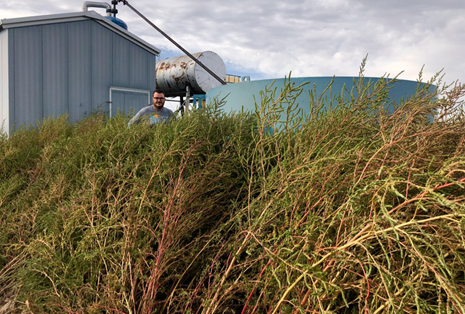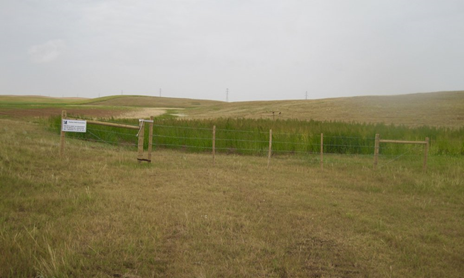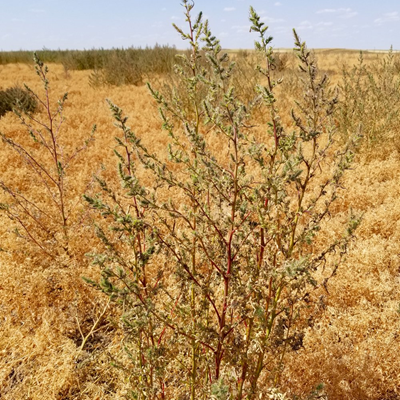When well sites are abandoned, the rent cheques often stop while the noxious weeds flourish
By Jeff Melchior
Published: October 9, 2019
Alberta Farmer Express

“Kochia six feet tall and completely covering the whole leases. We have many that look like this. When I phone, no one even answers the phones.”
This tweet from Lethbridge-area farmer Kevin Serfas in August likely could have been written by any one of hundreds of Alberta producers with abandoned well sites on their farms.
At last count, there were 150,000 energy leases in the province considered “orphaned” or inactive with no solid plans to reclaim them — some abandoned decades ago.
And those numbers from the Orphan Well Association inventory are on the low side, said Daryl Bennett, a farmer and director with the Alberta Surface Rights Federation.
“There are far more orphans than there are in the Orphan Well Association inventory and there’s a lot more coming,” said Bennett, citing Trident Exploration (a Calgary-based junior oil and gas company which ceased operation in May) as an example.
“Trident alone has 4,600 wells that haven’t hit the orphan well inventory yet.”
That leaves farmers such as Serfas not only dealing with unpaid rent but also having to figure out what to do with weeds. Kochia is a particularly bad one — not only a prolific seed producer but adept at developing herbicide resistance.
And even though he’s one of the biggest farm operators in the province (he and his family farm more than 50,000 acres), attempting to cut the kochia himself would be a logistical nightmare.
“I could manage them but with 50 or 60 leases on my property I would have to hire a full-time guy,” Serfas said.

The option of doing the work and billing the companies for the expense isn’t realistic either. Several unsuccessful attempts to reach some of the companies by phone and email have led him to wonder if they even still exist.
Nevertheless, several dry years in a row in southern Alberta have forged the perfect breeding conditions for kochia, which produces tumbleweeds that can spread its seeds far and wide. For producers with infected leases, it will likely fall on them to cut and spray it.
Kochia is difficult to manage and spreads quickly but has to be dealt with, said Charles Geddes, an Agriculture Canada researcher in Lethbridge.
“Everybody should take responsibility for (kochia),” he said. “If the plant is growing into the fall and has that tumbleweed structure, it should be cut off to stop it from tumbling away, which contributes to the expansion of this problem from field to field.”
A worsening situation
Aside from maintenance, the big question on the minds of many producers with abandoned wells on their properties is, “How am I going to be compensated?”
In January, the Supreme Court of Canada ruled in a landmark case dealing with failed oil and gas company Redwater Energy that bankrupt or insolvent energy companies must fulfil their environmental obligations before paying back creditors, including landowners.
But reclamation takes money, and lenders are not in a rush to come to the rescue of bankrupt companies, said Bennett. And the ruling has compounded the problems for ones struggling to survive, he added.
“It’s definitely made it harder for the smaller companies especially to get financing,” he said. “A lot of these companies are the ones neglecting to do proper weed control and maintain things.
“I talked to the vice-president of one company and he just said, ‘Look, we just don’t have the money.’”
Many companies are in that position, he added.
“It paints a pretty grim picture but that’s not the farmer’s issue. Farmers are entitled to have those leases taken care of in a timely manner and to receive their annual compensation.”
So what can producers do? Not much, said Bennett.
They can write to the Alberta Surface Rights Board and ask for help getting unpaid rent money for leases, but they will likely have to be patient.
“The surface rights board is at a crisis point,” he said. “It has a huge backlog, it doesn’t have enough staff and it probably has a limited budget. In some cases you can expect two years to have your annual compensation paid to you.”
As for getting companies to come out and cut kochia and other weeds, don’t hold your breath. “You can’t force anybody to take care of the weeds. The Orphan Well Association generally does not take care of weeds.”
High-maintenance weed
Southern Alberta continues to battle a growing population of kochia, having faced its third consecutive year of the dry conditions in which the tumbleweed thrives, said Geddes.
Kochia is usually managed throughout the growing season. However, Geddes said there are still things producers can do to manage it post-harvest and pre-seeding. For example, farmers who harvested around patches of kochia need to cut those patches as soon as possible.

“Our recent research is beginning to show that kochia seed becomes viable throughout or closer to the end of August. After that you start to see more and more viable seed on the plant, so the earlier you can get in there, the earlier you can cut the plant off and limit the production of viable seed.”
Cutting may not be enough, however.
Kochia is quite resilient and can regrow after harvest under the right environmental conditions, said Geddes. A post-harvest burn-down may be necessary. However, kochia is notoriously herbicide evasive and some populations are resistant to Groups 2, 4 and 9 herbicides.
“Once we see resistance in the Group 4s, that starts to drastically limit the options we have for effective herbicides in small-grain cereal crops like spring wheat,” he said. “But we still need to determine whether Group 4 resistance in kochia covers a single or multiple active ingredients within this site of action.”
There are chemical options available to manage triple-resistant populations. Geddes cites Infinity — a Group 6 and Group 27 combination herbicide — as one example.
The difficulty with Infinity and several other kochia-effective herbicides is they can leave behind residue in the soil, possibly limiting crop options in the following year. This is where longer-term thinking comes in.
“Planning out your rotation in advance can really help you get ahead of these kochia populations,” he said. “You can use these more effective herbicides if you plan to seed a crop next year that is not as sensitive to the residual impact of the herbicide.”
However, chemical solutions are just one part of an overall kochia-killing strategy, said Geddes. Crop competition is another.
“The weak point of the life cycle of kochia is that the seed has very little dormancy and persists only one or two years in the soil seed bank. Planning out your rotation to plant two competitive crops in a row could go a long way towards limiting seed production and eliminating that population.”
Another management practice is to plant winter wheat to compete with kochia. There’s not a lot of research data available in this specific area, said Geddes, but it’s something that “just makes sense.”
“If you seed a winter crop you have an established crop in the spring while kochia is trying to emerge.”
